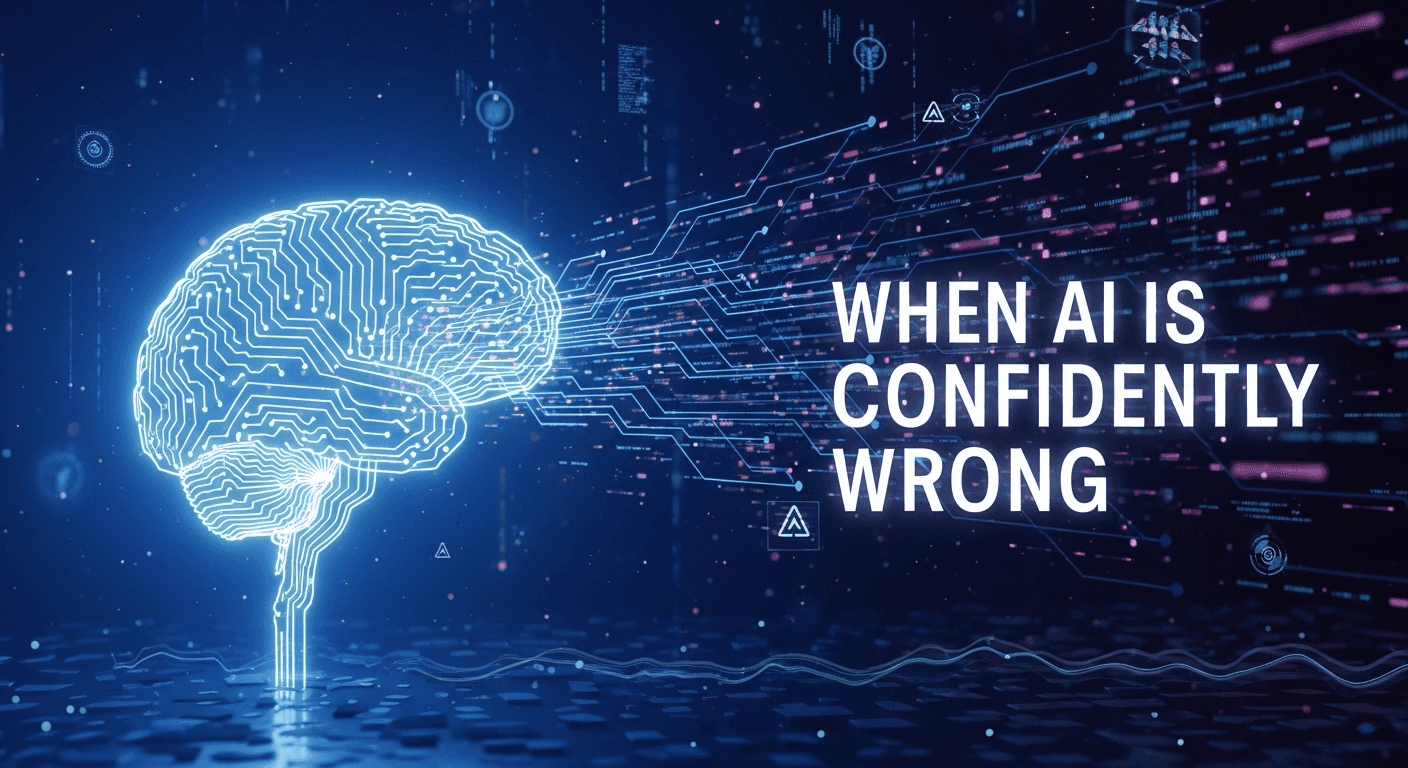Spotting AI Bias and Mistakes (When Smart Technology Gets It Wrong)
TrustByte Team
October 27, 2025

Day 3: Spotting AI Bias and Mistakes (When Smart Technology Gets It Wrong)
Introduction:
Let's start with an uncomfortable truth: AI is wrong. A lot.
It writes with confidence, presents information authoritatively, and rarely second-guesses itself. This makes it dangerously convincing — even when it's completely fabricated.
Yesterday, we learned that AI is a pattern recognition machine, not a thinking entity. Today, we're exploring what happens when those patterns lead it astray.
Because if you're going to work with AI, you need to develop what we call "AI skepticism" — the ability to spot when the machine is confidently wrong.
The Hallucination Problem
In AI terminology, a "hallucination" is when the system generates false information while presenting it as fact. It's not lying. Remember, AI doesn't know truth from fiction. It's simply predicting what text should come next based on patterns — and sometimes those predictions are completely fabricated.
Real examples of AI hallucinations:
- ChatGPT citing academic papers that don't exist, complete with fake authors and publication dates
- AI legal assistants inventing court cases that never happened (this actually got lawyers in serious trouble)
- Image generators creating photos of "historical events" that never occurred
- AI chatbots confidently providing incorrect medical or legal advice
Why does this happen?
Because AI learned that when you ask for a source, the pattern is to provide one. It doesn't matter if the source is real — only that it matches the pattern of what sources look like.
The Six Types of AI Mistakes You'll Encounter
1. Confident Fabrication - AI states false information with complete certainty. No hedging, no uncertainty markers.
Example: "The Eiffel Tower was completed in 1895" (it was 1889).
2. Outdated Information - AI's training data has a cutoff date. It doesn't know anything that happened after.
Example: Asking ChatGPT about events from last week will produce hallucinations because it's filling in patterns, not accessing current data.
3. Misunderstood Context - AI misses nuance, sarcasm, or context-dependent meaning.
Example: Taking a sarcastic tweet literally, or misunderstanding idioms from other cultures.
4. Logic Failures - AI struggles with tasks requiring step-by-step reasoning or common sense.
Example: Incorrectly solving math word problems despite showing work, or failing simple logic puzzles that children solve easily.
5. Biased Outputs - AI reproduces and amplifies biases present in its training data.
Example: Image generators producing mostly male doctors and female nurses, or resume screeners favoring certain demographics.
6. Consistency Failures - AI might contradict itself within the same conversation or provide different answers to identical questions.
Example: Saying "yes" to a question, then "no" when asked again with slight rephrasing.
Where AI Bias Comes From
AI bias isn't a glitch. It's a feature of how the system learns.
Consider this: If you train an AI on historical hiring data from the tech industry, it will learn patterns that reflect decades of gender imbalance. It will then recommend male candidates more often — not because it's sexist, but because that's the pattern in the data.
Common sources of AI bias:
- Historical bias: Training data reflects past discrimination and inequality
- Representation bias: Some groups are underrepresented in training data, leading to poor performance for those groups
- Measurement bias: The way data is collected or labeled introduces skewed perspectives
- Aggregation bias: Treating diverse groups as homogeneous leads to poor results for subgroups
- Deployment bias: Using AI in contexts different from its training environment
Real-world impacts of AI bias:
- Facial recognition systems that work better for lighter skin tones
- Loan approval algorithms that discriminate by zip code (a proxy for race)
- Voice recognition that struggles with non-American accents
- Job screening tools that filter out qualified candidates based on name, age, or education gaps
The Overfitting Problem
Here's a technical concept made simple: overfitting is when AI becomes too specialized in its training data.
Imagine studying for a test by memorizing answers to practice problems. You ace those exact problems but fail when the questions are rephrased. That's overfitting.
AI can become so tuned to its training examples that it loses the ability to generalize. This leads to:
- Brittle systems that fail when encountering slightly different inputs
- AI that works in lab testing but fails in real-world deployment
- Systems that can't adapt to changing circumstances
How to Develop AI Skepticism
Think of AI outputs as suggestions from an intern — smart, eager, but prone to mistakes. Here's your mental checklist:
For Factual Claims:
- Would this fact be easy to verify independently?
- Does the AI provide specific sources you can check?
- Does this align with what you already know?
- Is this topic likely to be in the AI's training data?
For Advice and Recommendations:
- Is this generic advice that could apply to anyone?
- Does it account for your specific context and constraints?
- Would a human expert give the same advice?
- What are the consequences if this advice is wrong?
For Creative Content:
- Does this sound formulaic or generic?
- Are there logical inconsistencies or plot holes?
- Does it lack specific, concrete details?
- Is it mixing up facts from different sources?
For Code and Technical Content:
- Does this code actually run without errors?
- Are there security vulnerabilities?
- Is this following current best practices?
- Does it account for edge cases?
Red Flags to Watch For
Learn to spot these warning signs:
- Overly confident language with no hedging ("definitely," "always," "never")
- Suspiciously perfect or round numbers
- Citations without URLs or with fake-looking references
- Contradictions within the same response
- Generic advice that doesn't address specific details you provided
- Anachronisms or timeline inconsistencies
- Advice that violates known safety or legal standards
The Verification Strategy
Never outsource critical thinking to AI. Instead:
- For important decisions: Verify AI outputs with authoritative sources
- For creative work: Use AI as a starting point, not the final product
- For learning: Cross-reference AI explanations with textbooks or expert resources
- For professional work: Have humans review before deploying AI-generated content
The Cascading Error Problem
Here's a newer concern: as AI-generated content floods the internet, future AI systems will be trained on that content.
This creates a feedback loop where AI trains on AI-generated text, potentially amplifying errors and biases with each iteration.
It's like making a photocopy of a photocopy — quality degrades each time.
Why This Matters for Educators
If you're teaching, you need to help students develop AI skepticism:
- Teach them that AI is a tool for exploration, not a source of truth
- Show examples of AI mistakes and have students identify the errors
- Require verification of AI-generated information
- Discuss bias and encourage students to question AI outputs
The goal isn't to avoid AI — it's to use it wisely.
Why This Matters for Professionals
If you're using AI at work:
- Never deploy AI-generated content without human review
- Understand the liability implications if AI makes costly mistakes
- Document your verification process for compliance and auditing
- Train your team on AI limitations and error patterns
Why This Matters for Business Owners
If you're implementing AI in your business:
- Test AI systems thoroughly before customer-facing deployment
- Have human oversight for high-stakes decisions
- Be transparent with customers about AI use
- Prepare for reputational damage if AI makes public mistakes
Next Post Preview
Now that you understand AI's limitations and how to spot its mistakes. In the next post, we're getting practical.
Next Post is all about effective prompting — how to communicate with AI in ways that minimize errors and maximize useful outputs.
You'll learn the techniques that separate people who get mediocre AI results from those who get exceptional ones.
Today's Action Step:
Take something AI generated for you recently — an email, a summary, some code, whatever.
Now fact-check it.
You'll likely find at least one error, exaggeration, or misleading statement. That's your AI skepticism muscle starting to build.
The most dangerous phrase in the age of AI is: "The AI said so."
The most powerful phrase is: "Let me verify that."



